
Product test
No more supermarket bread: I mill my own grain now
by Darina Schweizer

Basta with store-bought pasta! To make my own pasta, I tested the Marcato Atlas 150 machine. A sometimes tough affair.
If someone had told me five years ago that I would become a grinder (yes, with an h), I would have spit the supermarket croissant across the table with laughter. But since the beginning of the year, I've been grinding flour with the dedication of a Michmehlangelo.
Does that sound bland? Not at all! The wholemeal bread that comes out of it tastes so flavoursome that I've decided to expand my modest self-catering skills. I not only want to make my own bread, but also homemade pasta.
A suitable pasta machine is quickly at hand. After a few test reports and reviews, the choice falls on the Italian design icon Marcato Atlas 150. The machine is easy to use and clean and can be expanded with various attachments, they say. Proviamo a testare, let's try it out!
There are as many internet recipes for pasta dough as there are grains of flour. They all have one thing in common: one egg per 100 grams of flour. I opt for 500 grams, grind the grain and pile the fresh flour into a small mound. I dig a hollow in the centre. I first pour half a teaspoon of salt into it, then five beaten eggs and finally 2 decilitres of water.
I push everything together from the outside and start kneading. "When the dough is elastic and no longer sticks to your hands, it's ready," says the recipe. I knead. And knead and knead. The dough feels more and more crumbly. So I carefully add a little water. "Drop by drop", the recipe reminds me. And lo and behold: as I continue kneading, the cracks slowly come together. After about ten minutes, the dough feels elastic. This could be something. I leave it to rest for an hour, cut it into small portions and get it ready.
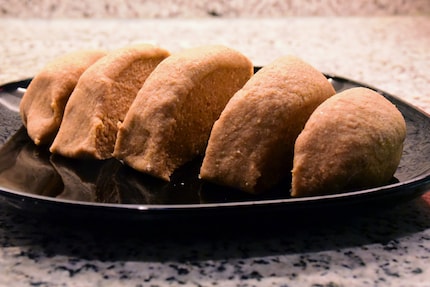
The machine is still less stable. I first have to fit it with a hand crank and secure it with a clamp. As I turn it tightly on the edge of the kitchen worktop, I feel like I'm back in school (screw clamp, I'll never forget you). And it gets just as dusty.
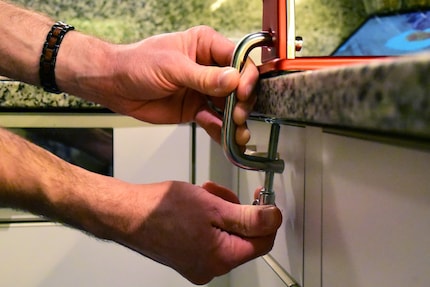
I take the first roll of dough and shape it into a flat oval by hand. I dust the front and back with flour. I quickly realise that this can only be done really evenly with a flour duster. I fold the dough once in the centre to get a nice edge. I will need this in a moment.
I carefully position the edge of the dough above the pasta roller. For the desired thickness, I pull the silver slider on the left outwards. At 0, for the greatest width, I snap it back in. I leave it here for five to six rounds. The dough needs this to form the gluten structure and remain stable.
Slowly, I start to turn the hand crank. My dough glides through smoothly for the first time. I can literally feel it being flattened. And then again. I fold it in the centre again, place the edge on the pasta roller and turn it through. Four more times. The dough slowly comes into shape. It's so much fun to turn!
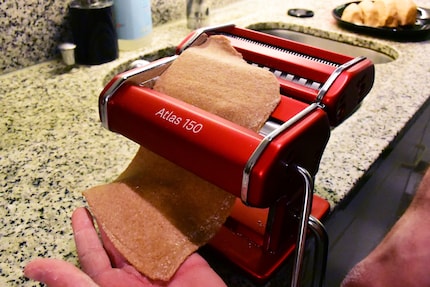
After the fifth pass, I shift my "kitchen Vespa" up a gear. I pull the silver knob outwards and let it snap back into place at 1. I turn the dough once through each stage until the fifth. It gets steadily thinner and longer. And crackier. It happens at level 4: There's a gaping hole in the centre of the dough. Che cazzo!
Is the dough too dry again? As I found out, freshly ground wholemeal flour absorbs more water than store-bought flour. The reason: it has a larger grain surface area. So I sprinkle the dough again with a little water and knead it again - perhaps that was also too short. When the dough forms small bubbles, I have a good feeling. As I read, this means that the gluten structure of the dough is stable and holds the gas in the dough.
Now it's back to stage 1, 2, 3, 4, 5 ... I impatiently go through all the stages again. And can finally breathe a sigh of relief: the dough has survived unscathed. Me too, halfway through. I'm pretty exhausted. Maybe I'll buy myself a motorised drive to do the cranking for me.
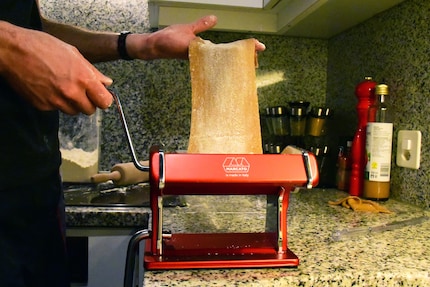
But first, let's continue with the manual work. I place the 50-centimetre-long piece of dough that I have rolled on the table in front of me. I cut the frayed ends straight at the front and back. Then I pull out the crank on the pasta roller and put it back in on the cutting roller.
The attachments supplied can be used to make three types of pasta (from very thick to very thin):
I opt for the golden mean: Fettuccine. With one hand I balance the dough towards the cutting roller, with the other I start turning. A really difficult task with this length of dough - and alone. You would need a second pair of hands (or a motor). I also notice: If the machine is attached to an edge rather than a corner, the pasta can't hang down nicely. I'll do it differently next time. But somehow I manage it and lo and behold: my first fettuccine come out of the machine.
Bellissima! I catch them in half with a measuring stick and transfer them to the pasta dryer. This is where they will hang out and dry for the next 12 hours to become shelf-stable.
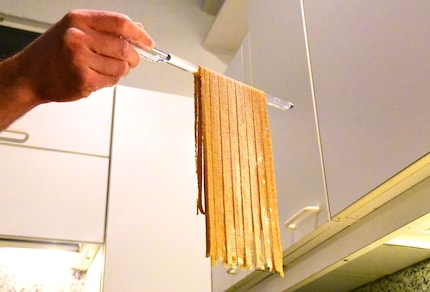
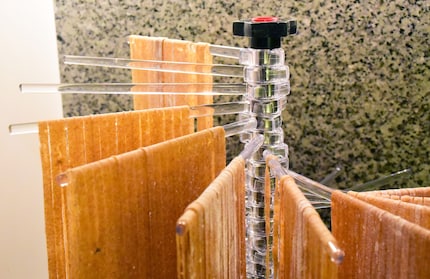
The next morning, I can remove the stiff pasta from the stand (sorry, I had to). I can keep them completely dry for around three months. But they won't last that long. The fettuccine only need to cook in boiling water for two minutes until they float to the top. Excited, I take the first bite. Consistency: grainy. I would definitely get a finer texture with white flour. Flavour: aromatic. I would never get it like this with white flour. Il test è un successo!
The situation was different when I tried vegan fettuccine a few weeks later. The tricky ratio of flour to water - already an art with conventional pasta - is particularly noticeable with the egg-free, thin pasta: after less than ten minutes on the pasta dryer, the bottom part of the fettuccine tears off, as if the dough is too heavy for itself.
Since then, I've been balancing precariously on the fine line between dough that is too sticky and dough that is too dry when making vegan pasta. Using more oil as a gluten or folding the pasta instead of hanging it has only worked moderately well. They just stuck together as a giant ball. But I'm not giving up on fettuccine. I'll keep rolling. After all, no Michmehlangelo has fallen from the sky yet.
Homemade pasta requires patience. It takes time to develop a feel for the right consistency of the dough and to go through the numerous rolling stages. But nothing tastes better than fresh pasta!
The Marcato Atlas 150 is an excellent helper for this. In terms of quality, it impresses across the entire pasta length. It is easy to clean with a brush and can be securely attached to all work surfaces. The attachments for different types of pasta are a useful addition. Only the motorised drive (which is only available in silver) could have been included in the higher purchase price. This would make it easier to make pasta on your own.
Pro
Contra
I love anything with four legs or roots - especially my shelter cats Jasper and Joy and my collection of succulents. My favourite things to do are stalking around with police dogs and cat coiffeurs on reportages or letting sensitive stories flourish in garden brockis and Japanese gardens.